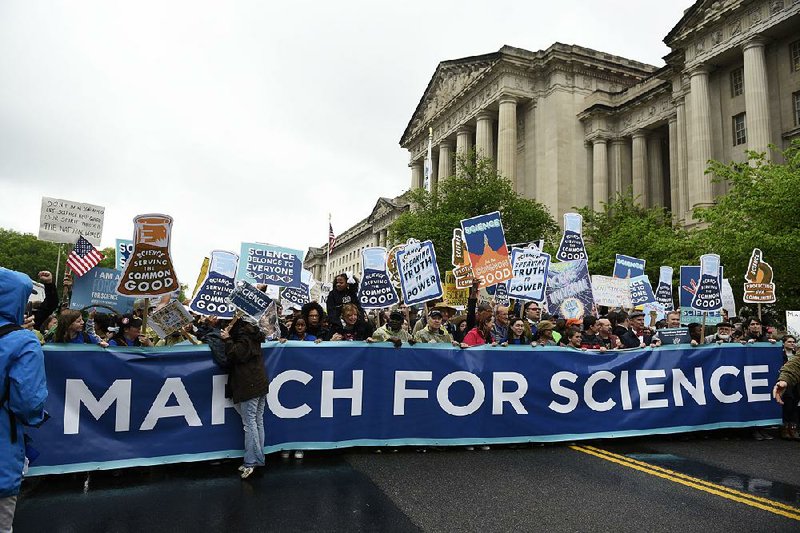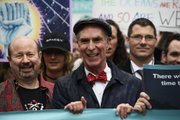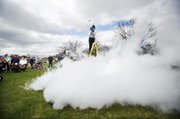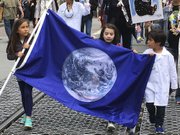WASHINGTON -- From the Washington Monument to Germany's Brandenburg Gate and even to Greenland, scientists, students and research advocates rallied Saturday on Earth Day. They conveyed a global message about scientific freedom without political interference, the need for adequate spending for future breakthroughs and the value of scientific pursuits.
RELATED ARTICLES
http://www.arkansas…">Rally at Capitol promotes sciencehttp://www.arkansas…">Hundreds march in Fayetteville to support science
The event took place on six continents and was cheered on by scientists on a seventh, Antarctica.
"We didn't choose to be in this battle, but it has come to the point where we have to fight because the stakes are too great," said Pennsylvania State University climate scientist Michael Mann, who regularly clashes with politicians.
President Donald Trump, in an Earth Day statement hours after the marches kicked off, said "rigorous science depends not on ideology, but on a spirit of honest inquiry and robust debate."
Denis Hayes, who co-organized the first Earth Day 47 years ago, said the crowd he saw from the speaker's platform down the street from the White House was energized and "magical" in a rare way, similar to what he saw in the first Earth Day.
"For this kind of weather this is an amazing crowd. You're not out there today unless you really care. This is not a walk in the park event," Hayes said of the soggy, chilly day.
Mann said that, like other scientists, he would rather be in his lab, in the field or teaching students. But driving his advocacy, he said, are officials who deny his research that shows rising global temperatures. When he stepped onstage, he got the loudest applause for his simple opening: "I am a climate scientist."
"We are at a critical juncture. Science is under attack," said Cara Santa Maria, a science communicator who was one of several emcees for the Washington rally. "The very idea of evidence and logic and reason is being threatened by individuals and interests with the power to do real harm," she said.
Scientist Tyler DeWitt, of YouTube fame, took the stage with another pointed message: Experts need to learn how to explain things in a way regular folks can understand.
"Ditch the jargon!" he said. "Make it understandable. Make people care. Talk to them, not at them. We cannot complain about slashed funding if we can't tell taxpayers why science matters."
Organizers said they wanted to erase the stereotype of science being stodgy and dominated by older white men, so Saturday's rally lineup included speakers from a broad range of ages, backgrounds and expertise.
There were some prominent names in science and environmentalism, including Bill Nye, chief executive of the Planetary Society and an honorary co-chairman of the march.
Other speakers included Taylor Richardson, a 13-year-old aspiring astronaut who raised $17,000 this year to send other girls to see the film Hidden Figures; chemist Mary Jo Ondrechen, a member of the Mohawk Nation and chairman of the board of the American Indian Science and Engineering Society; and Gallaudet University biologist Caroline Solomon, who is deaf.
Around the world
Rallies in more than 600 cities thrust scientists, who generally shy away from advocacy and whose work depends on objective experimentation, into a more public position.
Seven researchers in Antarctica went on Twitter to express their support for the march. In Australia, thousands of people gathered in Sydney, according to the Sydney Morning Herald. Science advocates went on social media to post bulletins from marches in such places as Austria, England and Malawi.
Scientists said they were anxious about political and public rejection of established science such as climate change and the safety of vaccine immunizations.
"Scientists find it appalling that evidence has been crowded out by ideological assertions," said Rush Holt, a former physicist and Democratic congressman from New Jersey who runs the American Association for the Advancement of Science. "It is not just about Donald Trump, but there is also no question that marchers are saying 'when the shoe fits.'"
Holt said the march was not partisan, but acknowledged that it was dreamed up during the Women's March on Washington, a day after Trump's Jan. 20 inauguration.
Three U.S. scientists, approached by a reporter, refused to answer questions for fear of repercussions at their workplaces.
Erik Molvar, director of the Western Watersheds Project, traveled from Wyoming. Molvar is a sage grouse expert who studies the impact of livestock on grouse habitat. Politicians supporting the livestock industry ignore his research into cheatgrass, which is highly flammable and leads to damaging wildfires, he said. "Livestock spread cheatgrass like mosquitoes spread the Zika virus," he said.
Organizers portrayed Saturday's march as political but not partisan. They said their purpose was to promote science and defend it against various attacks, including proposed U.S. government budget cuts under Trump -- such as a 20 percent cut at the National Institutes of Health. The Environmental Protection Agency faces a 31 percent budget cut and the elimination of a quarter of the agency's 15,000 employees.
Emily Fink, 28, and Kayla Denson, 29, are biomedical researchers who drove seven hours from Buffalo, N.Y., to attend the march, and said they fear that the proposed budget cuts will imperil their careers.
"It feels like we're getting our foot in the door right as the door is closing on us," Fink said.
Co-organizer and public health researcher Caroline Weinberg said, "It's not about the current administration. The truth is we should have been marching for science 30 years ago, 20 years, 10 years ago."
She said, "The current [political] situation took us from kind of ignoring science to blatantly attacking it. And that seems to be galvanizing people in a way it never has before. ... It's just sort of relentless attacks on science."
Some people in the sciences field expressed concern that the march only makes matters worse.
"I worry the march would drive the wedge deeper," said Robert Young, a coastal geologist at Western Carolina University who wrote a New York Times op-ed article in January expressing misgivings about the march.
Although Young planned to support friends at a satellite demonstration, he said it would be easy for conservatives to say the march was really about supporting liberal policies.
"Going to a march is easy," he said. "Spending the next couple of years reinventing how we communicate with red-state America, that's hard."
Touching on nerdy
The rallies were also about getting the word out regarding what science does for the world.
"Most people don't know how much funding for the sciences supports them in their lives every day. Every medical breakthrough, their food, clothing, our cellphones, our computers, all that is science-based," said Pati Vitt, a plant scientist at the Chicago Botanic Garden. "So if we stop funding scientific discoveries now, in 10 years, whatever we might have had won't be; we just won't have it."
In Washington, 9-year-old Sam Klimas of Parkersburg, W.Va., held up a red, handmade sign that read: "Science saved my life." He had a form of brain cancer and has been healthy for eight years.
Around the world, signs ranged from political to somewhat nerdy: "Make America think again," "What Do We Want? Evidence. When do we want it? After peer review." Some made reference to Star Trek and Star Wars.
There was a science-fair feel to Washington's rally. Lectures were given in tents, and there were hands-on science tables for kids. University of Minnesota physicist James Kakalios explained the science behind Superman, Spider-Man, the Fantastic Four and other superheroes.
In London, physicists, astronomers, biologists and celebrities gathered for a march past the city's most celebrated research institutions. In Spain, hundreds assembled in Madrid, Barcelona and Seville.
In Santa Fe, N.M., Kathryn Oakes Hall pinned a sign to the back of her T-shirt as she made her way to the march. It read: "Nine months pregnant, so mad I'm here."
She said she's worried about her baby's future in a world that seems to consider science disposable. Her husband is an engineer at Los Alamos National Laboratory. She studied anthropology and has a dog named Rocket.
Information for this article was contributed by Seth Borenstein, Claire Galofaro, Amanda Myers and Markus Schreiber of The Associated Press; by Joel Achenbach, Ben Guarino and Sarah Kapalan of The Washington Post; and by Nicholas St. Fleur, Emily Baumgaertner, Emily Palmer and Ben Fenwick of The New York Times.
A Section on 04/23/2017




